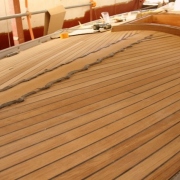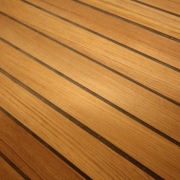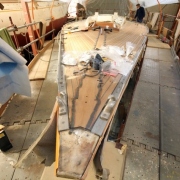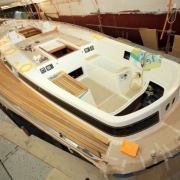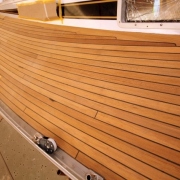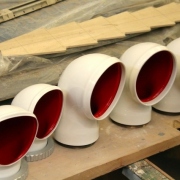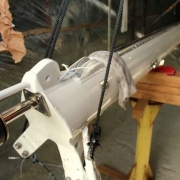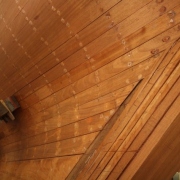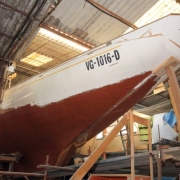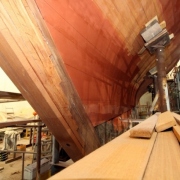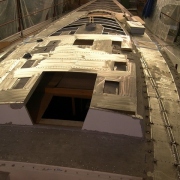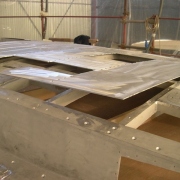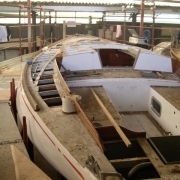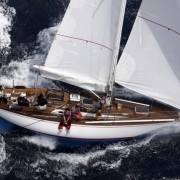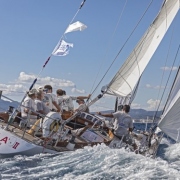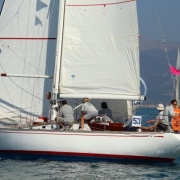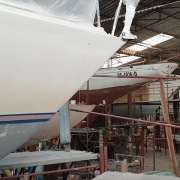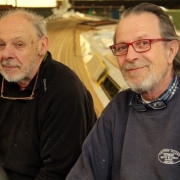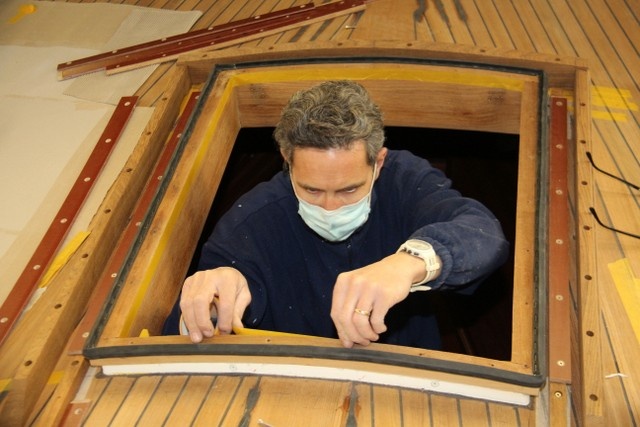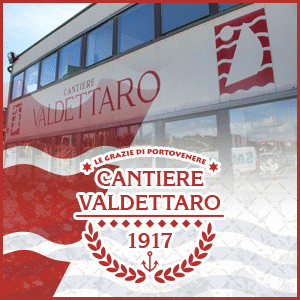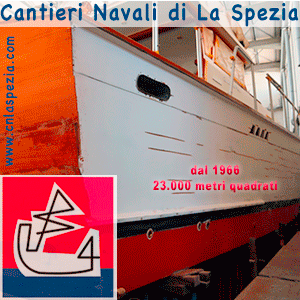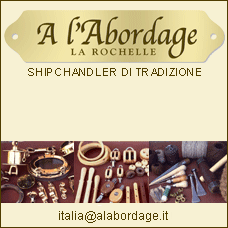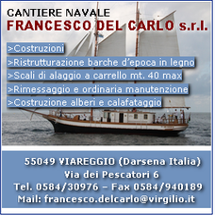 Quattro barche a vela storiche sottoposte a restauro, tutte progettate nell’ultimo mezzo secolo dal leggendario studio di progettazione navale Sparkman & Stephens di New York. È quanto accaduto recentemente presso il Cantiere Pezzini di Viareggio, storica realtà della cantieristica da diporto fondata in Toscana nel 1905. Le barche sono Ojalà II del 1973, costruita in alluminio, gli Swan classici in vetroresina Black Tie del 1981 e Vanessa del 1985 e infine Mait II, realizzata in legno nel 1957. Una dimostrazione di come le maestranze del Cantiere Pezzini siano in grado di intervenire indifferentemente su barche costruite con i principali materiali impiegati per la costruzione navale.
Quattro barche a vela storiche sottoposte a restauro, tutte progettate nell’ultimo mezzo secolo dal leggendario studio di progettazione navale Sparkman & Stephens di New York. È quanto accaduto recentemente presso il Cantiere Pezzini di Viareggio, storica realtà della cantieristica da diporto fondata in Toscana nel 1905. Le barche sono Ojalà II del 1973, costruita in alluminio, gli Swan classici in vetroresina Black Tie del 1981 e Vanessa del 1985 e infine Mait II, realizzata in legno nel 1957. Una dimostrazione di come le maestranze del Cantiere Pezzini siano in grado di intervenire indifferentemente su barche costruite con i principali materiali impiegati per la costruzione navale.
ITALIAN/ENGLISH TEXT
Di Paolo Maccione – Maggio 2021
Fotografie di Paolo Maccione
CANTIERE PEZZINI VIAREGGIO, YOUTUBE VIDEO
OJALÀ II, PUROSANGUE DA REGATA
Ojalà II è uno sloop Marconi lungo 11,54 metri, costruito in alluminio nel 1973 dal cantiere olandese Royal Huisman su progetto di Sparkman & Stephens. Dal 2009, come accaduto anche quest’anno, il Cantiere Pezzini (www.cantierepezziniviareggio.it) ne ha sempre curato la manutenzione ordinaria e straordinaria. La barca è sempre appartenuta alla famiglia inglese Holland, proprietaria dal 1950 del colosso Amplifon, leader mondiale nel settore degli apparecchi acustici. Innumerevoli le competizioni alle quali ha partecipato, tra cui il Fastnet e la One Ton Cup del 1973, 4 Middle Sea Race (1979-2013-2015-2017), numerose edizioni della Giraglia, Campionati del Mediterraneo, Settimana delle Bocche, Settimana di Alassio e 7 Campionati CIM riservati alle barche d’epoca e classiche. Nel 1977 ha attraversato l’Oceano Atlantico ed è rientrata in Europa l’anno successivo.

Dalla fine degli anni Ottanta la barca è sempre stata gestita dal velista milanese e coordinatore sportivo Michele Frova, classe 1953, ex dirigente di azienda nel settore utensileria, da sempre amico della famiglia Holland. Negli ultimi 12 anni la barca si è presentata sulla linea di partenza di almeno 150 regate. Nel solo 2018, oltre a vincere la Settimana Velica Internazionale di Livorno, la Settimana dell’Argentario e la Settimana di Napoli, ed essere salita sul podio in tutte le regate alle quali ha partecipato, si è aggiudicata le coppe AIVE del Tirreno e il Trofeo Sparkman & Stephens.
IL RESTAURO “A TAPPE” DI OJALÀ II
Il 2009 è stato l’inizio della rinascita di Ojalà II. Il Cantiere Pezzini ha smantellato la coperta originale in compensato marino di mogano, imbullonata a un reticolo di bagli in alluminio e doghe di teak larghe 45 millimetri e 12 millimetri di spessore. Successivamente si è proceduto alla sabbiatura della sovrastruttura e della cinta sul punto di attacco delle lamiere, che sono state così preparate per la saldatura delle nuove lamiere in alluminio dello spessore di 5 millimetri. È seguita la livellatura con stucchi epossidici e l’incollaggio con adesivi poliuretanici del nuovo ponte, composto da doghe di teak dello spessore di 12 millimetri e lunghezza superiore anche a 5 metri. Nel 2013 si è proceduto al rifacimento dell’impianto elettrico, nel 2015 è stato posato il nuovo motore Volvo Penta D2-55 da 55 HP (che ha incrementato di 1 nodo la velocità di crociera), nel 2017 sono state rifatte la cucina e la zona carteggio in legno di teak e il pagliolato. Nel 2019, dopo oltre 200.000 miglia di mare, il vecchio albero in alluminio Sparlight lungo 14,75 metri è stato sostituito da un nuovo albero a due ordini di crocette della Velscaf di Franco ‘Ciccio’ Manzoli, con profilo classico in alluminio e sartiame in tondino. Sempre quell’anno è stata eseguita la prima lamatura del ponte di Ojalà II.
LA VELATURA
L’attuale set di vele in dacron realizzato per Ojalà II, sono circa 25 quelle confezionate dal 2009 ad oggi, le consentono di competere indifferentemente nelle regate con certificati di stazza IRC, ORC International e CIM. Sempre quell’anno, a bordo di Ojalà II è salito il velaio Guido Cavalazzi, oggi Senior Designer Consultant nel settore vele classiche per North Sails, amico di gioventù del sopracitato team manager Frova nonchè velaio delle campagne italiane di Coppa America per Azzurra, Il Moro di Venezia e di Luna Rossa fino all’edizione di Valencia. Proprio per Il Moro, nel marzo 1992, Cavalazzi è stato il primo al mondo a realizzare a San Diego un genoa e una randa in laminato di carbonio, fornito dalla Montedison.
BLACK TIE, UN ALTRO ‘CLASSIC SWAN’ IN RESTAURO DA PEZZINI
Il passaparola conta. Dopo il refitting nel 2020 di Vanessa (leggi qui l’articolo), lo Swan 47 del 1985 di Matteo Salamon, Presidente della Sparkman & Stephens Swan Association, un altro armatore, l’imprenditore milanese Massimo Crovetto, ha scelto di avvalersi del Cantiere Pezzini per il restauro di Black Tie, il suo Swan 47 lungo 14,57 metri del 1981 (il 56esimo sui 70 ‘Swan 47’ varati dal cantiere finlandese Nautor tra il 1974 e il 1985). La barca, di colore nero come uno smoking, ha navigato diversi anni negli USA, poi è giunta in Europa. Entrata in cantiere a novembre 2020 tornerà a navigare entro l’estate. Anche in questo caso l’intervento più importante ha riguardato il rifacimento dei 37 metri quadrati della coperta con teak della Birmania. Tra gli altri lavori la riverniciatura del pozzetto e della tuga con Awlgrip di colore bianco, la sostituzione del plexiglass delle finestrature, boccaporti e oblò, la posa di un nuovo trave in ferro di appoggio in chiglia dell’albero, la riverniciatura degli interni in teak con vernici trasparenti bicomponenti e una mano finale di olio protettivo, la sabbiatura della carena, il trattamento antiosmosi e l’applicazione di antivegetativa, la lucidatura dell’opera morta. Rifatte anche le guide di scorrimento in Tufnol dei boccaporti e delle guarnizioni, invertita l’apertura delle panche del pozzetto, riverniciata la “fascia di bellezza” del paramare e della tuga e rianodizzate le componenti in alluminio di bordo (oblò, pastecche, goiot, ecc.).
LA POSA DELLA NUOVA COPERTA


Come è stato realizzato il nuovo ponte di Black Tie? Dopo lo smantellamento di quello vecchio si è provveduto a realizzare le nuove componenti del pozzetto, tuga, camminamenti laterali e panche, tramite dime in compensato. Il simulacro, tracciato sul pavimento, ha consentito di predisporre fasce di doghe di teak dello spessore di 12 millimetri. Ogni doga, incollata con adesivi poliuretanici previa livellatura e primerizzazione con un fondo isolante epossidico, ha una larghezza di 4,2 centimetri e una lunghezza massima di 6 metri con le attestature (dove termina una doga e ne inizia un’altra) tagliate all’inglese (ortogonali rispetto alla linea di chiglia). Le fasce più lunghe arrivano anche fino a 15 metri. Tramite apposite tabelle tecniche, che tengono conto di temperatura e umidità, sono state stabilite le tempistiche per la posa del nuovo teak. Il tempo di realizzazione è stato di circa 4 mesi. La rinnovata coperta, se trattata adeguatamente, soprattutto se spazzolata trasversalmente rispetto all’andamento longitudinale delle doghe, potrebbe durare ben oltre 15/20 anni.
LE MANOVRE VELICHE
Anche l’armo velico di Black Tie è stato oggetto di ricondizionamento. Dopo lo smontaggio e classificazione dell’attrezzatura, eseguita dall’attrezzista viareggino Francesco Dinelli, si è provveduto alla riprogettazione e semplificazione del piano di coperta e delle manovre veliche. Eliminata la rotaia della randa di cappa, con conseguente tappatura dei fori tramite rivetti svasati usualmente impiegati in campo aeronautico. L’albero in alluminio, originale dell’epoca, è stato sabbiato previa rimozione della canalina, cui è seguito l’isolamento con prodotti epossidici, la spruzzatura di sottosmalto poliuretanico, la brasivatura con grana fine e la posa a spruzzo di due mani di vernice Awlgrip Topcoat Off-White. Lucidate anche le parti in acciaio inox e anodizzata la ferramenta in alluminio.
MAIT II
Prosegue senza sosta da alcune stagioni il restauro di Mait II (), storico yawl bermudiano lungo 18,80 metri, costruito nel 1957 dal Cantiere Baglietto di Varazze (GE) su progetto di Sparkman & Stephens. La barca, appartenuta al Commendatore Italo Monzino, fondatore della Standa e mecenate dell’omonimo Centro cardiologico di Milano, è stata la prima barca italiana a partecipare nel 1959 alla regata del Fastnet con a bordo il navigatore Francis Chichester, non ancora Sir. In quella occasione Mait II si piazzò al settimo posto in Prima Classe RORC. Nel 1962 arrivò seconda alla Buenos Aires-Rio de Janeiro e partecipò anche ad alcune Middle Sea Race e alla Cape Town-Rio.
Oggi appartiene all’editore milanese Guido Tommasi. Tra gli interventi più recenti l’ultimazione della posa delle tavole di fasciame in mogano dello spessore di 32 millimetri, trattenute con circa 2000 chiodi in rame (realizzati in cantiere) di 8 millimetri di diametro, lunghi 10 centimetri e ribaditi internamente da altrettante rosette coniche. Tra i prossimi lavori il ripristino della pala e linea d’asse del timone, dell’astuccio dell’elica, del basamento per il nuovo motore e la ricostruzione degli interni progettati dallo Studio Faggioni. Alle attività di cantiere hanno partecipato in prima persona il titolare Massimo Pezzini, lo zio Sandro Pezzini e il viareggino Luca Sessa, l’operaio specializzato presente in cantiere dalla fine degli anni Ottanta.
INFORMAZIONI

www.cantierepezziniviareggio.it
Facebook: https://www.facebook.com/cantierepezziniviareggio
GALLERY
ENGLISH TEXT
Classic Sparkman & Stephens sail yachts are taken to new life at the Pezzini shipyard in Viareggio
Four refitted classic sailboats, all designed over the past half century by the legendary New York-based naval design firm Sparkman & Stephens. This is what has recently happened at the Pezzini shipyard in Viareggio, Italy, a historic yacht shipyard founded in Tuscany in 1905. The boats are Ojalà II (1973), built in aluminum, the classic S&S Swan, fiberglass made, Black Tie (1981) and Vanessa (1985) and, finally, the wooden Mait II (1957). It is the demonstration of the complete variety, in the shipyard skills, able to intervene on all types of materials with which the boats are built.
OJALÀ II, PUREBREDS RACING BOAT
Ojalà II is a Marconi sloop, one tonner IOR, 11.54 meter long, built in aluminum in 1973 by the dutch Royal Huisman shipyard, designed by Sparkman & Stephens . Every year, since 2009, the Pezzini Shipyard ( www.cantierepezziniviareggio.it ) takes care of her ordinary and extraordinary maintenance. The boat belongs, from the launch day, to the Holland family, founder and owner, since 1950 of Amplifon an Italy-based company active in the hearing care retail market. In her life, she has participated in countless regattas, including the Fastnet Race, the 1973 One Ton Cup , 4 times at the Middle Sea Race (1979-2013-2015-2017), many editions of the Giraglia , of the Mediterranean Championships, the “Settimana delle Bocche”, the Alassio Sailing Week, and 7 CIM/Panerai Trophy, reserved to vintage and classic boats . In 1977 she crossed the Atlantic Ocean and re-crossed it back to Europe, the following year. Since the end of the 80s, the boat has always been looked after, coordinated and skippered by Michele Frova, born in 1953, a Milanese sailor, close friend of the Holland family, former company manager in the hardware market. In the past 12 years the boat has been present on the course line of at least 150 races . Only in 2018 , in addition to winning the Livorno International Sailing Week, the Argentario Week and the Naples Week, she got on the podium in all the races in which she participated, and she was awarded the cups AIVE of Tirreno and the Sparkman & Stephens Trophy.
THE STAGE REFITTING PROCESS OF OJALÀ II
2009 was the beginning of the rebirth of Ojalà II. Pezzini Shipyard dismantled the original teak slats deck, 45 mm wide and 12 mm thick, screwed onto a mahogany marine plywood support, in turn bolted to a network of aluminum beams. Subsequently, the superstructure and the toe rail were sandblasted at the points of attachment and welding of the new 5 mm thick aluminum panels, cut and prepared for their welding to the existing beams. The process kept on by leveling the new aluminum surface with epoxy fillers and ended with the laying, with polyurethane glue, of the new deck, made up of teak slats, 12 millimeters thick and more than 5 meters long. In 2013 the whole electrical system has been renovated, in 2015 was installed a new engine Volvo Penta D2-55 - 55 HP, (which improved by 1 knot the cruising speed), in 2017 the galley and chart table areas have been completely and faithfully rebuilt in teak wood and the boat floor has been replaced. In 2019, after more than 200,000 sea miles , the old 14.75 meter long Sparlight aluminum mast was replaced by a new one, with two rows spreaders, made by Franco 'Ciccio' Manzoli 's Velscaf, with a classic aluminum profile and rod riggings. Also that year the first sanding of the Ojalà II bridge was carried out.
THE SAILS WARDROBE
The current dacron and nylon sail set of Ojalà II consist of about 25, made from 2009 to today, allowing her to compete indifferently with her IRC , ORC or CIM certificates. In 2009, Guido Cavalazzi got onboard Ojala II, as sails designer and crew member. Guido Cavalazzi, close friend, since his youth, of the team manager Michele Frova, is Senior Designer Consultant, in the classic area, at North Sails. He has been the sail designer and sailmaker of all the Italian campaigns at the America's Cup, for Azzurra , Il Moro di Venezia and Luna Rossa up to the Valencia edition. In particular, for Il Moro, in March 1992, Cavalazzi designed and produced the very first carbon laminate genoa, and mainsail, ever made in the world’s sails history. Those sails have been manufactured in San Diego, utilising raw material worked out in Italy, by Montedison.
BLACK TIE, ANOTHER 'CLASSIC SWAN' REFITTED BY PEZZINI
Word of mouth matters. After the refitting of Vanessa, in 2020 ( read here the article ), the 1985 Swan 47 belonging to Matteo Salamon, President of Sparkman & Stephens Swan Association, another Swan owner, the milanese entrepreneur Massimo Crovetto has decided to make use of Pezzini shipyard for the refitting of Black Tie , his Swan 47, 14.57 meters long, launched in 1981 ( she is n. 56, out of the 70 Swan 47 launched by the Finnish shipyard Nautor, between 1974 and 1985 ). The boat, black as a “tuxedo”, the american meaning for “smoking”, sailed for several years in the USA , then arrived in Europe . It entered the shipyard in November 2020 and will return to sailing within next summer. In her case, as well, the most important intervention involved the refurbishment of her 37 square meters deck, with Burma teak. Among other works, the cockpit and the coach roofrepainting, with white color Awlgrip, the replacement of the plexiglass of side windows, companionways and hatches, the replacement, in the keel, of the iron structure supporting the mast, the teak interior repainting, with two-component clear coatings and a final coat of protective oil, the hull sandblasting, followed by the anti-osmosis treatment and antifouling, the topsides polishing. Sliding guides of all companionways, made by Tufnol, have also been replaced, as well as seals. The opening system of stowage lockers, in the cockpit, has been improved, by reversing the opening direction. Coaming and coach roof stripes have been repainted, and all aluminium deck fittings re-anodized (portholes, blocks, hatches etc.).
THE LAYING OF THE NEW DECK
How has been the new Black Tie deck built? After the dismantling of the old one, the new deck areas of cockpit, plywood templates were made on the cockpit, coachroof, side walkways, and benches areas, using plywood templates . The simulacrum, drawn on the lab ground, made it possible to prepare bands of teak slats 12 millimeters thick. Each plank , glued with polyurethane adhesives after leveling and priming with an epoxy insulating base, has a width of 4.2 cm and a maximum length of 6 meters with the headers (where one plank ends and another begins) cutted according to the English style (orthogonal to the keel line). The longest bands reach up to 15 meters. The timing of laying the new teak panels has been established according to specific technical tables, which take into account temperature and humidity. The new deck construction timing process took about 4 months. The new deck, if well treated, especially if brushed crosswise with respect to the longitudinal course of the slats, could last in optimal conditions over 15/20 years.
SAIL MANEUVERS
Mast, boom and all deck gear and fittings have been refitted, as well. After the disassembly and classification of the equipment, worked out by the viareggino Toolmaker Francesco Dinelli, the deck plan and the sailing maneuvers were redesigned and simplified. The storm trysailmast groove has been eliminated, with consequent closing of the relative holes by means of countersunk rivets normally used in the aeronautical field. After removing the mainsail mast groove, the original aluminum mast has been sandblasted, electrically insulated, with epoxy products, sprayed with polyurethane undercoat, abrasivaded with fine grain and finally sprayed with two coats of Awlgrip Topcoat Off -White paint . All stainless steel parts have been polished and all aluminium hardware re-anodized.
MAIT II
Slowly, but tirelessly continues, since several seasons, the refitting of Mait II ( ), the historical yawl Bermudian 18,80 meters long, designed by Sparkman & Stephens, built in 1957 by Baglietto Shipyard, at Varazze (GENOVA). The boat, originally belonged to Commendator Italo Monzino, founder of “Standa” (italian department store shop chain) and patron of the homonymous cardiological center of Milan, was the first Italian boat to participate in 1959 at the Fastnet race. Francis Chichester, not yet Sir, was onboard. On that occasion Mait II finished in seventh place in First Class RORC ranking. In 1962 she was second at the Buenos Aires-Rio de Janeiro. She also participated to more than one Middle Sea Race and to the Cape Town to Rio. Today she belongs to the Milanese publisher Guido Tommasi. Among the most recent interventions, we note the completion of the mahogany hull planking boards, 32mm thick, fixed with about 2000 copper nails, 10 cm long, 8 mm diameter (made in the shipyard), internally riveted by conical rosettes. Next steps are the restoration of the rudder blade and shaft, of the propeller shaft case, of the base for a new engine, and the reconstruction of the interior furnitures, designed by Studio Faggioni. All shipyard activities are carried out by the owner, Massimo Pezzini, his uncle Sandro Pezzini, and the Viareggino Luca Sessa, a skilled worker, active in the shipyard since the end of the 80s.
INFORMATION
www.cantierepezziniviareggio.it
Facebook: https://www.facebook.com/cantierepezziniviareggio






